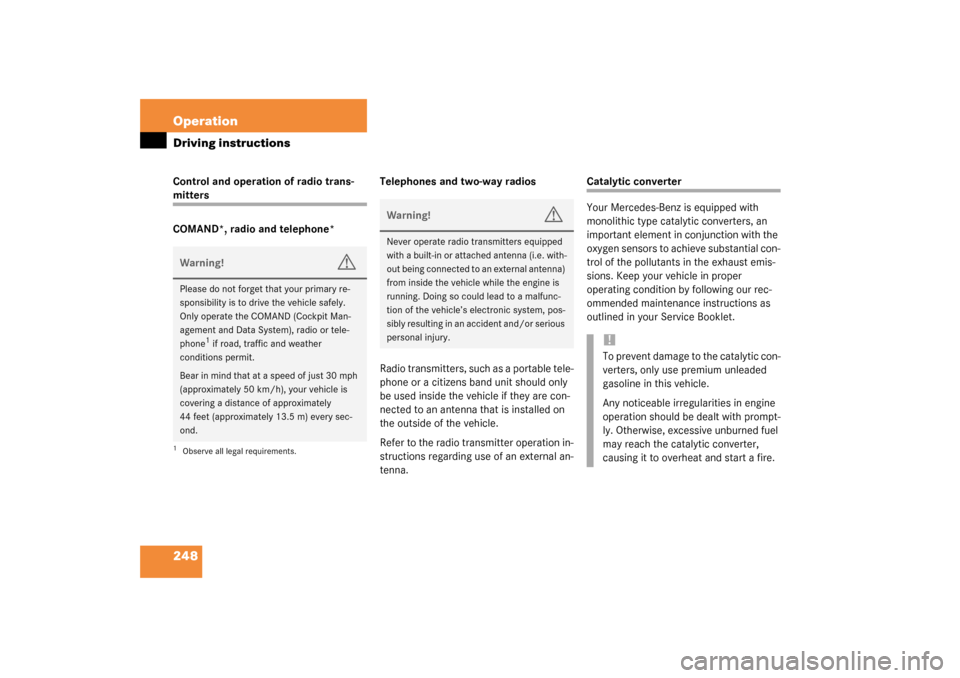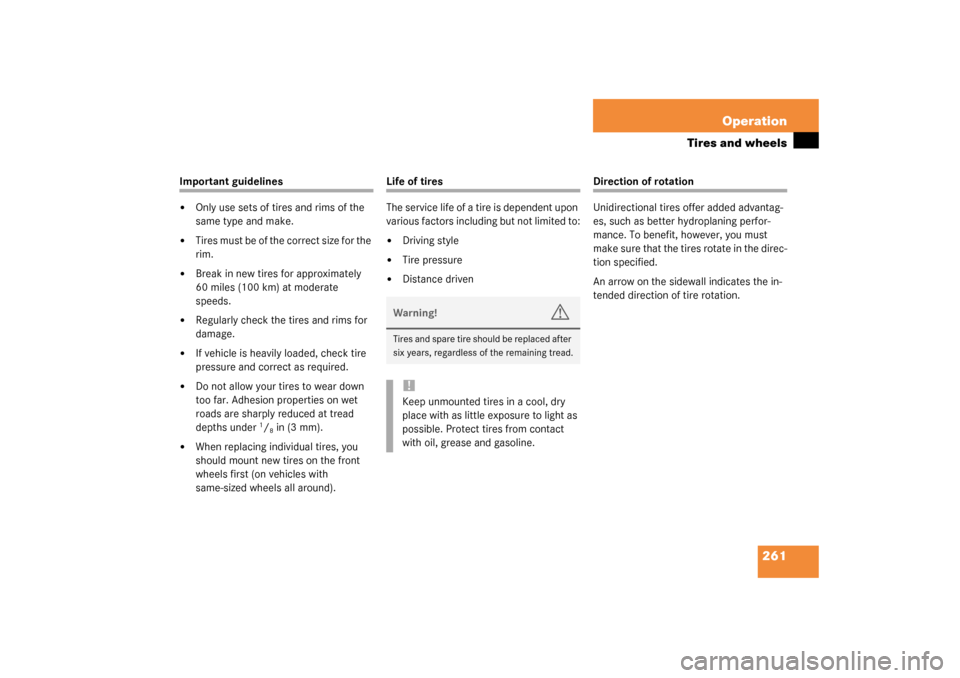Page 248 of 394

248 OperationDriving instructionsControl and operation of radio trans-mitters
COMAND*, radio and telephone*Telephones and two-way radios
Radio transmitters, such as a portable tele-
phone or a citizens band unit should only
be used inside the vehicle if they are con-
nected to an antenna that is installed on
the outside of the vehicle.
Refer to the radio transmitter operation in-
structions regarding use of an external an-
tenna.
Catalytic converter
Your Mercedes-Benz is equipped with
monolithic type catalytic converters, an
important element in conjunction with the
oxygen sensors to achieve substantial con-
trol of the pollutants in the exhaust emis-
sions. Keep your vehicle in proper
operating condition by following our rec-
ommended maintenance instructions as
outlined in your Service Booklet.
Warning!
G
Please do not forget that your primary re-
sponsibility is to drive the vehicle safely.
Only operate the COMAND (Cockpit Man-
agement and Data System), radio or tele-
phone
1 if road, traffic and weather
conditions permit.
Bear in mind that at a speed of just 30 mph
(approximately 50 km/h), your vehicle is
covering a distance of approximately
44 feet (approximately 13.5 m) every sec-
ond.
1Observe all legal requirements.
Warning!
G
Never operate radio transmitters equipped
with a built-in or attached antenna (i.e. with-
out being connected to an external antenna)
from inside the vehicle while the engine is
running. Doing so could lead to a malfunc-
tion of the vehicle’s electronic system, pos-
sibly resulting in an accident and/or serious
personal injury.
!To prevent damage to the catalytic con-
verters, only use premium unleaded
gasoline in this vehicle.
Any noticeable irregularities in engine
operation should be dealt with prompt-
ly. Otherwise, excessive unburned fuel
may reach the catalytic converter,
causing it to overheat and start a fire.
Page 261 of 394

261 Operation
Tires and wheels
Important guidelines�
Only use sets of tires and rims of the
same type and make.
�
Tires must be of the correct size for the
rim.
�
Break in new tires for approximately
60 miles (100 km) at moderate
speeds.
�
Regularly check the tires and rims for
damage.
�
If vehicle is heavily loaded, check tire
pressure and correct as required.
�
Do not allow your tires to wear down
too far. Adhesion properties on wet
roads are sharply reduced at tread
depths under
1/8in (3 mm).
�
When replacing individual tires, you
should mount new tires on the front
wheels first (on vehicles with
same-sized wheels all around).
Life of tires
The service life of a tire is dependent upon
various factors including but not limited to:�
Driving style
�
Tire pressure
�
Distance driven
Direction of rotation
Unidirectional tires offer added advantag-
es, such as better hydroplaning perfor-
mance. To benefit, however, you must
make sure that the tires rotate in the direc-
tion specified.
An arrow on the sidewall indicates the in-
tended direction of tire rotation.
Warning!
G
Tires and spare tire should be replaced after
six years, regardless of the remaining tread.!Keep unmounted tires in a cool, dry
place with as little exposure to light as
possible. Protect tires from contact
with oil, grease and gasoline.
Page 317 of 394

317 Practical hints
Replacing bulbs
Front lamps Rear lamps Notes on bulb replacement
Lamp
Type
1
Low beam
1
1Vehicles with Bi-Xenon headlamps* do not replace
the Bi-Xenon bulbs yourself.
H7 (55 W)
Bi-Xenon*
D2S-35 W
2
High beam
H7 (55 W)
Parking and stand-
ing lamps
W 5 W
3
Additional turn sig-
nal lamps
LED
4
Turn signal lamp
1156 NA
5
Side marker lamp
W 5 W
6
Fog lamp
HB4/9006
(55 W)
Lamp
Type
7
Rear fog lamp, driv-
er’s side
P 21/4 W
Turn signal lamp
P 21 W
Brake lamp
P 21 W
Backup lamp
P 21 W
Tail, parking and
standing lamp, side
marker
P 21/4 W
W 5 W
8
High mounted brake
lamp
LED
9
License plate lamps
C 5 W
Warning!
G
Keep bulbs out of reach of children.
Bulbs and bulb sockets can be very hot. Al-
low the lamp to cool down before changing
a bulb.
Halogen lamps contain pressurized gas. A
bulb can explode if you:�
touch or move it when hot
�
drop the bulb
�
scratch the bulb
Wear eye and hand protection.
Because of high voltage in xenon lamps, it is
dangerous to replace the bulb or repair the
lamp and its components. We recommend
that you have such work done by a qualified
technician.